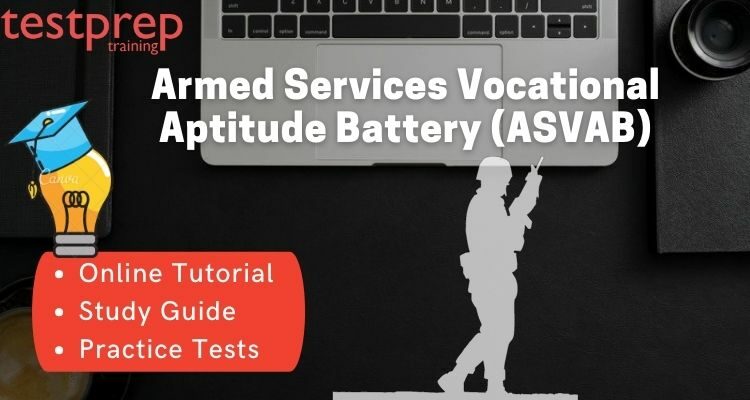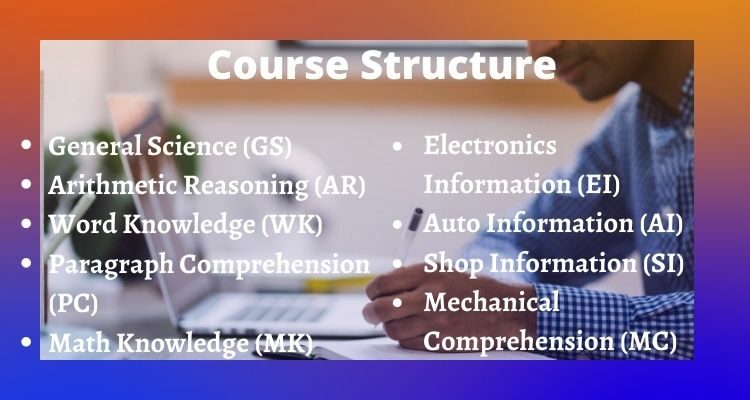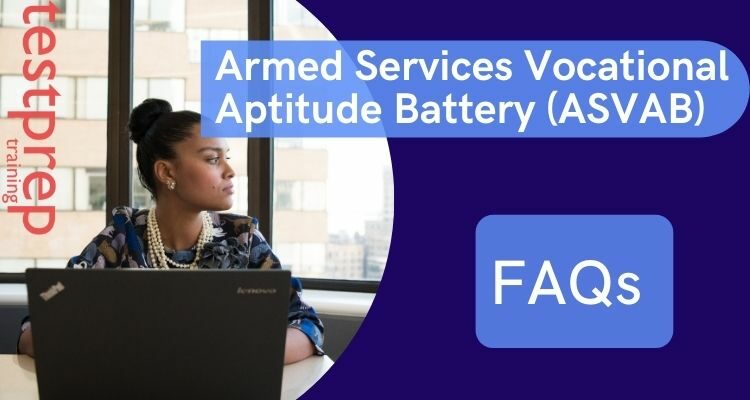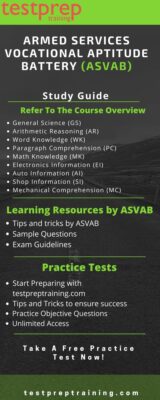Armed Services Vocational Aptitude Battery (ASVAB)

The Armed Services Vocational Aptitude Battery (ASVAB) is a test battery designed and developed in 1996 by the Department of https://www.testpreptraining.com/armed-services-vocational-aptitude-battery-asvab-practice-examDefense by the U.S as a standardized instrument for measuring necessary skills and requirements needed for personnel selection and classification in 1976. This eventually became an official testing instrument in all the U.S military branches. After undergoing a major revision in 2002, currently, it consists of nine or ten times (including pen-paper and computer-based modes) multiple-choice tests in the field of work knowledge, paragraph comprehension, arithmetic reasoning, mathematics knowledge, general science, auto and shop information, mechanical comprehension, electronics information, and assembling objects. The first four tests establish the eligibility criteria for the exam and others are used to determine interests and aptitudes. Also, in some of the cases, high school students are given the ASVAB is a necessary part of the application process for the potential military recruits.
Who should take the ASVAB Exam?
The ASVAB test is usually offered to high school students in the U.S. The students who are studying in the 10th, 11th, 12th grade.
Any candidate who is interested and wants to join the defense army can apply for the ASVAB test.
Eligibility Criteria for giving the ASVAB Test
To get enlisted for the ASVAB exam is not that easy. The candidates are supposed to successfully pass the ‘An Armed Forces Qualification Test’. The AFQT score determines the fundamental qualification for enlistment.
AFQT score division-
- Category I: 93–99
- Category II: 65–92
- Category III A: 50–64
- Category III B: 31–49
- Category IV A: 21–30
- Category IV B: 16–20
- Category IV C: 10–15
- Category V: 0–9
Air Force – eligibility score is 36
Army – eligibility score is 31
Marine Corps – eligibility score is 32
Navy – eligibility score is 35
Coast Guard – eligibility score is 40
ASVAB Exam Details
There are two modes of giving this exam-
The Computerized ASVAB
- The computerized ASVAB (also known as the CAT-ASVAB) is an adaptive test, which means it adjusts to your level of competence. Based on your replies to previous things in the exam, the computer software selects items that are appropriate for you. Because of this, It is feasible to administer a shorter CAT-ASVAB because it is tailored to your ability level. In the paper and pencil administration, a different test is used. You may work through the CAT-ASVAB at your own pace. When you finish a test in the battery, you can move on to the next area without having to wait for everyone else to finish. You are free to exit the testing room once you have completed all of the tests. Despite the fact that each examination has a set number of questions and a time limit, the majority of examinees complete the test before the time limit expires.
- The CAT-ASVAB takes the typical examinee about 1 1/2 hours to complete.
- Once you’ve submitted an answer on the CAT-ASVAB, you won’t be able to go back and amend it. If you’re running out of time, it’s better to keep answering as best you can than to make random guesses for the remaining items, the CAT-ASVAB has a penalty for guessing.
The Pen-Paper Test
- The classic ASVAB (also known as the P&P-ASVAB) is a paper and pencil test in which everyone answers the same set of questions at the same time. The number of test questions and time restrictions for each test are listed. The P&P-ASVAB takes roughly 3 hours to complete in total.
- You have the option of reviewing your responses on the P&P-ASVAB. You cannot, however, return to a previous test portion or move to the next test until you are prompted to do so. If you run out of time on the P&P-ASVAB, it’s better to fill in random guesses for the remaining items, as guessing has no penalty.
Course Outline for ASVAB Test

General Science (GS)
Having the knowledge of physical and biological sciences (Science/Technical)
Arithmetic Reasoning (AR)
Having the ability to solve arithmetic word problems (Math)
Word Knowledge (WK)
How to select the correct meaning of a word presented in context and to identify the best synonym for a given word (Verbal)
Paragraph Comprehension (PC)
Having the ability to obtain information from written passages (Verbal)
Mathematics Knowledge (MK)
Having knowledge of high school mathematics principles (Math)
Electronics Information (EI)
Study of electricity and electronics (Science/Technical)
Auto Information (AI)
Having the knowledge of automobile technology Science/Technical
Shop Information (SI)
Having knowledge of tools and shop terminology and practices (Science/Technical)
Mechanical Comprehension (MC)
Having knowledge of mechanical and physical principles (Science/Technical)
Assembling Objects (AO)
Determining how an object will look when its parts are put together (Spatial)
Registration Process
You will need to contact a military recruiter if you want to take the ASVAB in order to apply for the military.
Go to www.todaysmilitary.com/request-information to find a recruiter near you. If you are otherwise qualified, the recruiter will schedule an ASVAB test for you at the nearest Military Entrance Processing Station (MEPS) or an allied Military Entrance Test (MET) site.
ASVAB FAQs
Click here to know all the exam details and clear your doubts and queries.

What to expect when taking the ASVAB?
- Screening applicants to verify they meet the requirements is an important element of a recruiter’s work. A recruiter will inquire about your marital status, health, education, drug use, and arrest record even before sending you to take the ASVAB. It’s critical that you respond to these questions honestly and truthfully. You will be scheduled to take the ASVAB once the recruiter has determined that you are qualified for further processing. At that time, a physical examination may also be performed.
- Visit the Military Entrance Processing Command website for more information about military entrance processing.
- Applicants are tested for the ASVAB at Military Entrance Processing Stations or MEPS. The MEPS is a joint-service organization of the Department of Defense that employs both military and civilian personnel. There are 65 MEPS spread across the United States and Puerto Rico.
- If you live far from a MEPS, the ASVAB can be taken at a satellite location known as a Military Entrance Test (MET) site. MET locations are frequently found in federal government office buildings, National Guard armories, or Reserve centers.
- To be admitted to the testing room, you must bring valid identification. If you arrive late, you will be turned away and forced to reschedule. Your recruiter may provide transportation to and from the session, but he or she is not permitted to enter the testing room.
- The ASVAB test questions are considered controlled testing materials. You should not accept or provide information about specific test questions to other people.
- Applicants who provide or receive information about test questions face severe penalties.
- The ASVAB is administered by computer at the MEPS and at the majority of MET locations. The paper-and-pencil version is available at a few MET locations. Depending on the mode of administration, testing procedures will differ. When taking the ASVAB, you are not permitted to use a calculator.
ASVAB Exam Score Report
- Examinees are also given a score on the Armed Forces Qualification Test (AFQT).
The AFQT scores are derived from the Standard Scores of four ASVAB subtests: Arithmetic Reasoning (AR), Mathematics Knowledge (MK), Paragraph Comprehension (PC), and Word Knowledge (WK). - The AFQT scores are reported as percentiles ranging from 1 to 99. An AFQT percentile score represents the percentage of examinees in a reference group who scored at or below that level. The reference group for current AFQT scores is a sample of 18 to 23-year-old youth who took the ASVAB as part of a national norming study conducted in 1997.
- Thus, an AFQT score of 90 indicates that the examinee scored on par with or better than 90% of the nationally-representative sample of 18 to 23-year-old youth. An AFQT score of 50 indicates that the examinee performed at or above the level of 50% of the nationally-representative sample.
- ASVAB scores are mostly used to determine enlistment eligibility, assign applicants to military jobs, and help students with career exploration.
Preparatory Guide
To ensure your success on the ASVAB exam, you’ll need an effective plan that directs your efforts in the right direction. This is a well-planned and systematic exam preparation guide that contains all of the exam details and resources you need to ace this exam. Begin preparing with Test Prep Training right away!

Refer to the Course Structure
When preparing for the ASVAB exam, it is critical to thoroughly understand all of the topics from the course structure. Make certain that you have a thorough understanding of each and every domain. More information about the course structure can be found by clicking here.
Computerized test format
- General Science (GS)
- Arithmetic Reasoning (AR)
- Word Knowledge (WK)
- Paragraph Comprehension (PC)
- Mathematics Knowledge (MK)
- Electronics Information (EI)
- Automotive and Shop Information (AS)
- Mechanical Comprehension (MC)
- Assembling Objects (AO)
- Verbal Expression (VE)
Written test format
- General Science (GS)
- Arithmetic Reasoning (AR)
- Word Knowledge (WK)
- Paragraph Comprehension (PC)
- Mathematics Knowledge (MK)
- Electronics Information (EI)
- Automotive and Shop Information (AS)
- Mechanical Comprehension (MC)
- Assembling Objects (AO)
- Verbal Expression (VE)
ASVAB Learning Resources
The ASVAB Testing Program does not endorse any specific method of test preparation other than recommending that examinees take a solid core of math, English, and science courses in high school and/or college.
This kind of academic preparation will help you perform better on Arithmetic Reasoning, Mathematics Knowledge, Paragraph Comprehension, Word Knowledge, and General Science subtests. Taking technical courses will also help you perform better on the subtests Auto Information, Shop Information, Electronics Information, and Mechanical Comprehension.
Steps to Take Prior to the Actual Test Day recommended by the ASVAB
- Prepare well in advance of the test date.
- Understand what to expect on test day.
- [Visit the What to Expect page]
- Familiarize yourself with the ASVAB subtest content. [Visit the ASVAB Subtests page]
- Examine sample questions and review content areas where you need to brush up on your knowledge [Visit the Sample Questions page]
- Determine whether you will take the paper-and-pencil (P&P) ASVAB or the CAT-ASVAB, as optimal test-taking strategies differ between the two. [It should be noted, however, that the test content is the same in both versions.]
- Get a good night’s sleep the night before the test.
Practice Tests
Take as many free practice tests as you want and assess your own performance. These practice exams are meticulously designed by domain experts and professionals with the course objectives in mind. Each set of practice questions is different and unique, and it is designed to boost the candidate’s confidence. These practice tests will ensure your ASVAB exam success.

